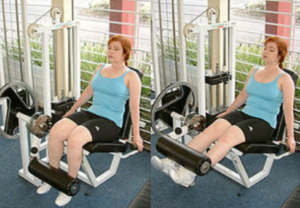How long can you stand on one leg without holding onto anything?
Have you ever tried this? If you’re older and bomb at this, you should worry.
Research from the Mayo Clinic reveals that a person’s ability to stand on one leg is a significant indicator of aging, even more so than changes in strength or walking ability.
Published in the journal PLOS ONE, this study emphasizes the importance of balance for older adults, as balance is so important for living independently.
As people age, maintaining good balance becomes essential.
But the fact is that few people, including older ones, who regularly exercise pay much attention to developing prime balance skills.
Balance involves the coordination of various systems, including vision and sensory feedback, making it a vital measure of physical fitness.
Balance Study on One Legged Standing

Shutterstock/ Jacob Lund
The study involved 40 healthy and independent participants over age 50, divided into two groups: those under 65 and those over 65.
The researchers assessed the subjects through tests that measured walking, balance, grip strength and knee strength.
During the balance tests, participants stood on force plates under different conditions, such as with their eyes open or closed, and while balancing on one leg.
The tests lasted 30 seconds, and the results showed that the ability to stand on the non-dominant leg declined significantly with age.
This decline in balance is very relevant since poor balance increases the risk of falls, a major health concern for older adults.
Falls are a leading cause of injuries in those over 65, often resulting from a loss of balance.
In addition to balance, the study measured grip strength and knee strength.
Grip and Knee Strength

George Stepanek
Participants used a custom device to assess grip strength, while knee strength was tested in a seated position.
Both grip and knee strength showed declines with age, but grip strength decreased more rapidly, indicating it may serve as a better predictor of aging than other measures of strength.
The study also noted that the declines in grip and knee strength did not differ based on sex, suggesting that both men and women experienced similar aging effects in these areas.
Gait Tests
Interestingly, the gait tests, which involved walking along an eight-meter pathway at a normal pace, did not reveal significant changes with age.
This finding was somewhat expected, as participants walked at their own speed rather than pushing their limits.
The balance and gait tests also showed no notable differences between the sexes, indicating that age affects both genders equally in these aspects.
Balance Training: The Fountain of Youth

Credit: Saidel
It’s been said that strength training or lifting weights is the Fountain of Youth.
And indeed, it most certainly is! But we need to add balance training to that as well.
Dr. Kenton Kaufman, the study’s senior author, says that simple exercises, like standing on one leg, can help individuals improve their balance and maintain it over time.
He suggests that being able to stand on one leg for 30 seconds is a good indicator of balance health. This drill means that your hands are free, not holding onto anything.
Dr. Kaufman advises that people can take proactive steps to improve their balance.
Regular practice does not require any special equipment and can easily be integrated into daily routines.
He states, “If you don’t use it, you lose it. If you use it, you maintain it.”
Exercise for Balance
As a former personal trainer as well as lifelong fitness enthusiast, I need to point out that there’s quite a few ways to improve balance.
Strength training the lower body actually improves balance, so just standing on one leg should not be your only mode of balance exercise.
Do you walk outside for fitness? If so, the next question is: Do you use walking sticks or a similar device such as hiking poles?
If so, ditch them. These rob your body’s ability to get better at balance.
If you’re a treadmill user, do you hold on? DON’T – unless you’re momentarily checking for heart rate, drinking water or changing the settings.
One of the biggest mistakes I see older people at the gym making is that of holding onto a treadmill.
If you walked into the gym without a walker or cane, you medically do not need to hold onto a treadmill.
 Lorra Garrick is a former personal trainer certified by the American Council on Exercise. At Bally Total Fitness, where she was also a group fitness instructor, she trained clients of all ages for fat loss, muscle building, fitness and improved health.
Lorra Garrick is a former personal trainer certified by the American Council on Exercise. At Bally Total Fitness, where she was also a group fitness instructor, she trained clients of all ages for fat loss, muscle building, fitness and improved health.
.









































